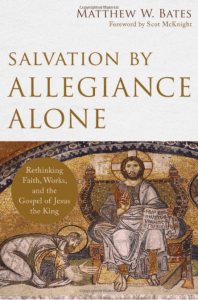 It all depends on how the gospel is framed. Is it about how to go to heaven when you die? About being released from guilt? About liberation from some kind of (spiritual or social) slavery? Let this be said over and over: How we frame the gospel determines what the response is.
It all depends on how the gospel is framed. Is it about how to go to heaven when you die? About being released from guilt? About liberation from some kind of (spiritual or social) slavery? Let this be said over and over: How we frame the gospel determines what the response is.
Which means, we’ve got to get the gospel right. Which is what Matthew Bates attempts in Salvation by Allegiance Alone. Bates is a young and noteworthy scholar today, his theology is orthodox and his exegesis careful. This is a remarkable book — buy it, read it, and discuss it. (You will rise up and call me blessed.)
The common gospel is one that proceeds through a way of getting saved. Bates calls it abbreviated and truncated. “The plot in the abbreviated gospel is self-centered: 1 have a problem (sin) and I am currently on the road to perdition, but Jesus died for my sins, so now I have the opportunity to change roads—to go to heaven. All that is required is my personal faith that Jesus’s death completely saves me from my sins” (29). “Moreover, this truncated gospel assumes that the ultimate goal for humanity is spiritual bliss in heaven rather than … embodied participation in the new heavens and the new earth” (29).
“The most straightforward explanations of what the word “gospel” meant for the earliest Christians are found in three passages in Paul’s Letters, Romans 1:1-5, 1:16-17, and 1 Corinthians 15:1-5 (cf. 2 Tim. 2:8). Another passage that does not use the word euangelion but aligns closely with the above mentioned is Philippians 2:6-11, which can help fill out our understanding” (30).
So what is it?
… the gospel is the power-releasing story of Jesus’s life, death for sins, resurrection, and installation as king, but that story only makes sense in the wider framework of the stories of Israel and creation. The gospel is not in the first instance a story about heaven, hell, making a decision, raising your hand after praying a certain prayer, justification by faith alone, trusting that Jesus’s righteousness is sufficient, or any putative human tendencies toward self-salvation through good works. It is, in the final analysis, most succinctly good news about the enthronement of Jesus the atoning king as he brings these wider stories to a climax (30).
Bates then goes through these passages building toward that summary — and I think profoundly accurate — of the gospel itself.
What happens to the response when the gospel is about the enthronement of the king? We turn to the word allegiance.
Rom 1:3-4: “[the gospel] concerning his Son, who as it pertains to the flesh came into existence by means of the seed of David; who as it pertains to the Spirit of Holiness was appointed Son-of-God-in-Power by means of the resurrection from among the dead ones—Jesus the Christ our Lord” (his translation).
The gospel is the V pattern: at the throne of God, incarnation, enthronement.
1 Cor 15: It is about Jesus; he dies on our behalf (substitution); his story is in accordance with scriptures/Story of Israel; this gospel is the property of the early church; this gospel unleashes redemption, as Rom 1:16-17 show:
Rom 1:16-17; “For I am not ashamed of the gospel, for it is the power of God for salvation for everyone who gives allegiance to Jesus as the Christ, to the Jew first and also to the Greek. For in the gospel the righteousness of God is revealed by means of Jesus’s allegiance to God; this righteousness becomes ours through our allegiance to Jesus the king. For both Jesus and us, all of this accords with the prophetic word, “But the righteous one shall live by allegiance.’ (his translation)
The gospel is an announcement about Jesus not first and foremost about me or you or us. It is about him. It is about Who he is and what he has done and his status in the universe. The proper response to this Who, What and Where is Allegiance to the Enthroned King.
This gospel is the gospel that calls for allegiance because it focuses on the king. It is a gospel of allegiance.











